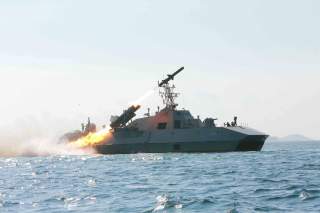How Will the U.S. Navy Counter China and Russia's New Ship-Killer Missiles?
America's rivals are building more ship-killers. A lot more.
Key Point: Will it work?
The U.S. Navy and numerous NATO partners are firing a new, high-tech ship defense weapon that can identify, track and attack maneuvering anti-ship missiles with an active seeker enabling the missile to change course in flight, service officials said.
The Evolved Sea Sparrow Missile Block II, or ESSM, is a new version of an existing Sea Sparrow weapons system currently protecting aircraft carriers, destroyers, cruisers, amphibious assault ships and other vessels against anti-ship missiles and other surface and airborne short-range threats to ships.
The recent live-fire test follows the successful completion of two Controlled Test Vehicle flight tests in June 2017 and is the first in a series of live fire tests that will lead to the ESSM Block 2 missile entering production, Naval Sea Systems Command spokesman Alan Baribeau told Warrior Maven.
The ESSM Block 2 live-fire exercise marked the first use of the weapon’s active seeker system, emerging technology which enables the missile achieve improved flight guidance to its target by both receiving and actively sending electromagnetic signals, Navy officials said.
The ESSM uses radar technology to locate and then intercept a fast-approaching target while in flight; the use of what’s called an “illuminator” is a big part of this capability, Raytheon developers told Warrior Maven in prior interviews.
The current ESSM missiles use what’s called a semi-active guidance system, meaning the missile itself can receive electromagnetic signals bounced off the target by an illuminator; the ESSM Block 2’s “active” guidance includes illuminator technology built onto the missile itself such that it can both receive and send important electromagnetic signals, Navy and Raytheon officials explained.
Block 2 relieves the missile from the requirement of having to use a lot of illuminator guidance from the ship as a short-range self-defense, senior Navy officials have said.
A shipboard illuminator is an RF signal that bounces off a target, Raytheon weapons developers have explained. The antenna in the nose in the guidance section [of the missile] sees the reflected energy and then corrects to intercept that reflective energy, the Raytheon official added.
The emerging missile has an “active” front end, meaning it can send an electromagnetic signal forward to track a maneuvering target, at times without needing a ship-based illuminator for guidance.
Also, the missile is able to intercept threats that are close to the surface by sea-skimming or diving in onto a target from a higher altitude, Navy officials explained.
The so-called kinematic or guidance improvements of the Block 2 missile give it an improved ability to counter maneuvering threats, Navy and Raytheon officials said.
ESSM Block 2 is being jointly acquired by the U.S. and a number of allied countries such as Australia, Canada, Denmark, The Netherlands, Norway and Turkey. All these countries signed an ESSM Block 2 Memorandum of Understanding, or MOU, designed to solidify the developmental path for the missile system through it next phase. The weapon is slated to be fully operational on ships by 2020.
The collaborative mission, according to the text of US Dept. of State’s ESSM Block 2 2014 Memorandum of Understanding with participating nations, is to “cooperatively design, develop, test and evaluate an upgraded ESSM that employs a dual mode X-band active and semi-active guidance capability, leveraging existing technology to the maximum extent practicable.”
Recommended: Forget the F-35: The Tempest Could Be the Future
Recommended: Why No Commander Wants to Take On a Spike Missile
Recommended: What Will the Sixth-Generation Jet Fighter Look Like?
U.S. Navy weapons developers are working closely with NATO allies to ensure the weapon is properly operational across the alliance of countries planning to deploy the weapon.
The ESSM Block 2 weapon is part of what Navy officials describe as a layered defense system, referring to an integrated series of weapons, sensors and interceptors designed to detect and destroy a wide-range of incoming threats from varying distances.
For instance, may ships have Aegis Radar and SM-3 missiles for long-range ballistic missile defense. Moving to threats a litter closer, such as those inside the earth’s atmosphere such as anti-ship cruise missiles, enemy aircraft, drones and surface ships, the Navy has the SM-6, ESSM, Rolling Airframe Missile and SeaRAM for slightly closer threats.
When it comes to defending the ship from the closest-in threats, many ships have the Close-In-Weapons System, or CIWS, which fires a 20-mm rapid-fire Phalanx gun toward fast approaching surface and airborne threats.
Kris Osborn, Managing Editor of Warrior Maven, where this was first posted. He can be reached at [email protected],
Image: Korea Central News Agency via Reuters.

